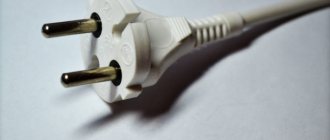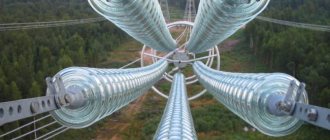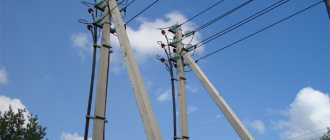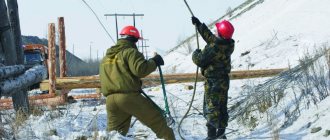Causes of overhead power line breaks
Date: January 4, 2011 |
Category: Articles, Electrical installation work Tags: , Laying cables in the ground This material was prepared by specialists.
Do you need electrical installation or electrical measurements? Call us! The New Year's news feeds in our country are more and more reminiscent of the script of a new film - a disaster. Hundreds of large settlements are cut off from electricity, tens of thousands of people celebrate the holidays in sheepskin coats by candlelight. Airports are unable to receive and dispatch planes, holding crowds of passengers hostage. Heat guns are used to heat people. They have enormous thermal power and can heat not only unheated or poorly heated rooms, but also outdoor areas. The use of heat guns is widespread on farms and households, on construction sites and retail areas. What types of heat guns are there? Diesel locomotives are appearing on railways instead of the usual electric trains. The reason for all these troubles is the same - the weather is abnormal for the central regions. Freezing rain, heavy snowfall, low temperatures.
As a result of such weather disasters, an ice crust (ice) forms on the wires of overhead power lines. The thicker this crust of ice, the heavier the wire becomes. When the thickness of the ice reaches a critical level, insulators shatter into pieces, wires break, and overhead power line supports fall.
We should not forget that overhead power lines pass not only through open areas, but also through forests. Tree trunks and branches, under the weight of snow and ice, fall onto the wires, which inevitably leads to breaks, short circuits and fires. This is what we have been seeing everywhere lately.
Is it all Mother Nature's fault? And why do we always refer to abnormal weather phenomena? Chubais has not been at the helm of the energy complex for a long time, and emergency situations occur with enviable regularity all the time.
Most power outages could be avoided if power companies periodically carried out work to clear overhead power lines of trees, cut clearings and monitor the condition of poles, insulators and wires, especially since these electrical installation works are included in the cost of electricity.
Do not forget that when designing power lines, preference is given to overhead lines, since it is believed that it is much cheaper. But power engineers are cunning, because overhead power lines require large costs for their maintenance and restoration after the next abnormal weather event, although from an economic point of view it would be more rational to lay cable lines in the ground instead of overhead lines.
A cable power line consists of one or more cables laid in the ground or in special cable structures - boxes, tunnels, overpasses. Modern technologies make it possible to use cables for all voltage classes. Laying cables in the ground is possible in cities, towns, and on the territories of industrial enterprises. Now, as a rule, cable lines are used where it is not possible to build overhead lines. Cable lines have undeniable advantages over overhead power lines. The main disadvantage of overhead power lines is that they are subject to many vagaries of nature. Cable lines laid in the ground do not depend on natural phenomena. Unless there is a global earthquake with a shift in the earth's crust or an unknown volcano erupts.
Overhead power lines require a specific space called a containment zone. It is prohibited to build any structures or carry out any type of work in this zone. It’s no secret what level land prices have now reached, so renting land for a line or buying it into ownership will require very large costs.
Underground power lines are not visible from the surface of the earth, therefore, unlike overhead lines, they will not spoil the appearance of city landscapes. It is also preferable to lay cables in densely built areas and where construction is planned in the future. When using cables, losses at high loads are significantly reduced, which will supply consumers with higher quality electricity. And saving energy resources is currently considered the main direction in energy policy.
Currently, in most large cities of our country, projects for the long-term development of underground cable laying are being implemented, which provide for an increase in the length of cable lines. In the near future, it is planned to remove most of the overhead power lines into the ground, that is, to dismantle the overhead lines and lay new cable lines in the ground. After all, the use of these technologies will make it possible to most effectively plan urban development and develop energy systems in modern megacities.
Other and useful information
Other and useful information
What to do if you fall
The first thing to do if you notice a tree falling on an electrical wire line is to call the emergency service and notify its specialists of the situation.
Then it is necessary to photograph or video record the tree after it falls on the wires, and in the presence of several witnesses, also document everything in writing. It is also necessary to notify law enforcement authorities.
This is necessary in a situation where there is a threat of causing moral damage. In this case, a special check may be required to ensure the absence of illegal actions regarding the property of the victim (if any).
If, as a result of a falling tree, electrical wires were damaged, which resulted in large-scale material damage, a special inspection can be ordered to assess the condition of the fallen tree, the damage caused as a result of its fall, and also to identify the culprit. The results of this check can become key evidence if you suddenly have to resolve the issue in court.
To speed up the elimination of the consequences of a falling tree, you can also involve a management company, which, in addition to the emergency service, can also be contacted.
It should also be remembered that if there is a break in the wires, it is strictly prohibited to be near them, especially in wet weather. Otherwise, you may suffer from electric shock.
The procedure for determining a broken wiring in the wall
Finding the location of the damage, regardless of the cause of the problem, is carried out in the following order:
- First of all, you need to de-energize the wiring. To do this, turn off the automatic switch (switch).
- Sometimes it is necessary to reduce the resistance level of the insulating layer of the wiring; to do this, it is burned through.
- To search for a damaged area, they resort to induction or acoustic methods; you also need to arm yourself with an ordinary household multimeter and a transistor receiver.
- To make searching easier, electricians also use locators. These devices, which have different modifications, allow you to accurately determine the path along which the cable is laid, find all current-carrying conductors, and also find out whether they are energized or not. Some models use them together with generators to increase efficiency.
Innovative electrical networks equipped with lines of beacon markers have been invented. This installation method is actively used in Europe and America. In Russia, this method has not yet become widespread. In this case, if the integrity of the wire is violated, the locator, based on a signal from the beacon, will quickly and with high accuracy determine the location of the break.
Amounts of penalties
In situations where the culprit of a tree falling on a power line is a human factor (independent cutting of a trunk or branches), a fine cannot be avoided.
The legislation for the breakdown of power lines with voltages up to 1 kV establishes the following fines, as stated in Article 9.7 of the Code of Administrative Offenses:
- for the population the amount of fines is 1-1.5 thousand rubles;
- for officials the fine is 2-3 thousand rubles;
- for legal entities, the amount of penalties is 20-30 thousand rubles.
In situations where, as a result of a falling tree, an electrical cable with a voltage exceeding 1 kV breaks, the fines will be:
- for the population - 1-2 thousand rubles;
- for officials - 3-4 thousand rubles;
- for legal entities - 30-40 thousand rubles.
If the damage to the wires, which resulted in material damage, occurred due to the human factor, it will have to be compensated by the person who caused the tree to fall.
Therefore, in order to avoid unpleasant moments in the form of fines, if the need arises to cut down a tree whose branches are located near nearby power lines, it would be more advisable to call specialists.
You should also keep in mind that it is strictly forbidden to touch trees that do not belong to you. This may be regarded as damage to municipal property, and in order to avoid penalties, special permission must be obtained.
This is worth paying attention to especially for residents of apartment buildings, who often have the desire to cut down trees that are in their way.
The Electrical Installation Rules indicate that special security zones should be located at a distance of 2-55 meters from the passage of power lines on the right and left sides. If the distance does not comply with regulatory documents or the mentioned zones are missing, this will also entail penalties.











